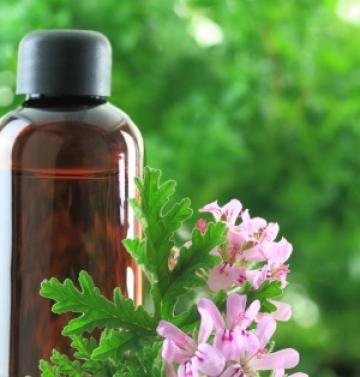 Geranium is one of the most popular essential oils, both because of its many therapeutic properties (antibacterial, anticandida, anti-inflammatory, anxiolytic..) and its pleasant fragrance.
Geranium is one of the most popular essential oils, both because of its many therapeutic properties (antibacterial, anticandida, anti-inflammatory, anxiolytic..) and its pleasant fragrance.
The International Trade Center’s monthly Market Insider publication features a regular review of essential oil-bearing crops. In July 2015 the focus was on geranium, the cultivation of which has become a tool for the economic emancipation of underdeveloped regions in Africa.
We are thankful to the International Trade Council for permission to republish the text in its entirety here.
Geranium oil of commerce is the essential oil distilled from the leaves of a number of species, varieties and strains of Pelargonium. The plant is a short term perennial shrub. Pelargoniums hybridize so readily that it is not useful to talk of particular species. However, an important consequence of this is that planting is always from cuttings to maintain the characteristics of the planting material.
Geranium oil is widely used as an important floral component in fragrances, cosmetics and household items where fragrance is needed. It is a major component in the soap industry, and is also used in pharmacy, herbal medicine and aromatherapy. There are many clinical, scientific publications which document its antiseptic properties and beneficial influence on human wellbeing and psychological condition. Citronellol and geraniol ex-geranium are the major constituents of Rhodinol, an important component of the fine fragrance industry.
Pelargoniums are native to South Africa, but were brought to Europe in the 17th century, and the first cultivation for distillation of the essential oil was in France. The plant was subsequently re-exported to the French colonies in Africaand elsewhere, and then more widely. At some stage a very wide range of countries have established commercial production of geranium oil – France, Spain and Italy; Algeria, Morocco and Egypt in North Africa; Congo in Central Africa and Kenya in East Africa; Madagascar and Réunion in the Indian Ocean; Russia (the Black Sea coast and Crimea); India; and China. Kenya also developed commercial production, but of a different type (termed Oil of Mawah), from either a hybrid of P. graveolens x P. radula, or a variety of P. radula (P. raduta var. quercifolium).
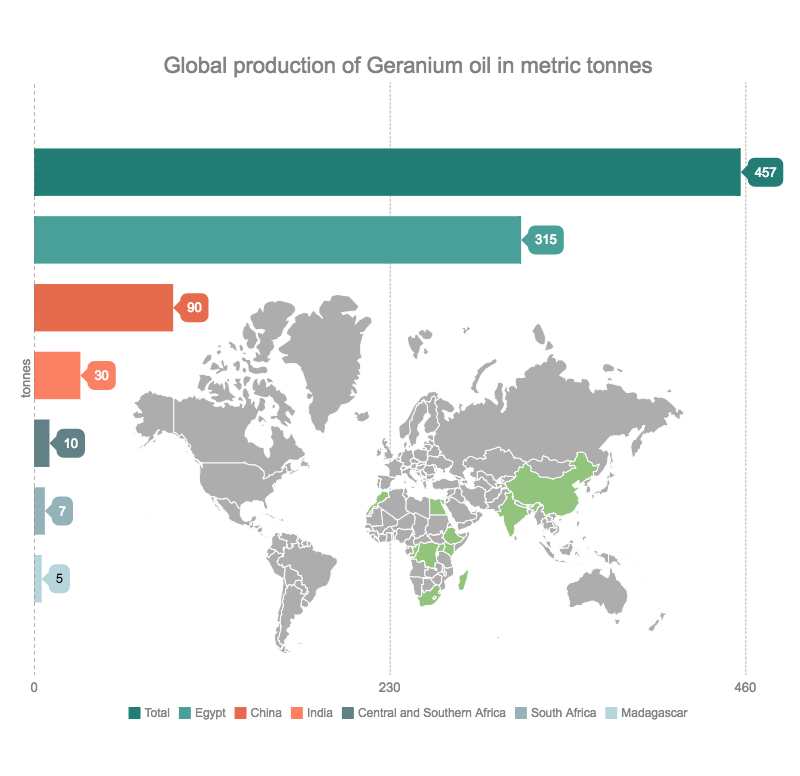 However, despite early commercial production being dominated by Réunion and Algeria, currently production is dominated by Egypt and China, with minor quantities available from a range of East and Southern African origins. Combined annual production for Egypt and China is currently estimated in the range 280 to 350 tonnes, against a world total in the range 350 to 400 tonnes. Over the past 5 to 6 years Egypt has substantially increased its production into the range 200 to 230 tonnes, whereas China has remained in the range 80 to 100 tonnes, India 25 to 35 tonnes, Madagascar around 5 tonnes, South African 5 to 10 tonnes, and other Central and Southern African origins providing another 10 tonnes. Morocco, Congo, Ethiopia, Uganda, Kenya have made recent attempts to re-establish production. Production in China was significantly higher in the early 2000’s, in the range 80 to 230 tonnes, but production has decreased from these peaks as growers have changed to cultivation of other, more remunerative horticultural crops, and geranium has been pushed out to less developed areas. In both Egypt and China, significant commercial production of geranium oil did not start until 1970.
However, despite early commercial production being dominated by Réunion and Algeria, currently production is dominated by Egypt and China, with minor quantities available from a range of East and Southern African origins. Combined annual production for Egypt and China is currently estimated in the range 280 to 350 tonnes, against a world total in the range 350 to 400 tonnes. Over the past 5 to 6 years Egypt has substantially increased its production into the range 200 to 230 tonnes, whereas China has remained in the range 80 to 100 tonnes, India 25 to 35 tonnes, Madagascar around 5 tonnes, South African 5 to 10 tonnes, and other Central and Southern African origins providing another 10 tonnes. Morocco, Congo, Ethiopia, Uganda, Kenya have made recent attempts to re-establish production. Production in China was significantly higher in the early 2000’s, in the range 80 to 230 tonnes, but production has decreased from these peaks as growers have changed to cultivation of other, more remunerative horticultural crops, and geranium has been pushed out to less developed areas. In both Egypt and China, significant commercial production of geranium oil did not start until 1970.
Geranium oil is complex in composition, and differs (is characteristic) by origin. The primary characteristics of the two major sources on the market, Egyptian and Chinese are:
| Constituent | Chinese type | Egyptian type |
| Citronellol | 32-43% | 25-36% |
| Geraniol | 5-12% | 10-18% |
| 6,9-Guaiadiene | 3-7% | up to 0.5% |
| 10-Epi-γ-Eudesmol | none | 3-6% |
In Egypt, production is concentrated in the Beni-Suef and Fayoum in Upper Egypt (around 70 miles south of Cairo). The crop is planted in October/ November, and a single harvest of the whole aerial part is made in June, when the plant is blossoming. The plant is therefore treated as an annual crop. In other areas the crop is maintained for 2 to 3 years, and 2 harvests are taken each year, in June/July and October/November, and at each harvest only the aerial part above 3 green budding eyes on the central stem is taken to allow regeneration after harvest.
It is estimated that the current crop is around 3,500 ha. The average oil yield is around 0.15% to 0.2%, giving production of around 60-70 kg/ha geranium oil. The oil is obtained by steam distillation of the leaves. Harvested material is generally left to wilt for 1-2 days before distillation. It is estimated that around 8,000 families are involved in the production of geranium oil; and if all others involved in the whole supply chain are included (middlemen, factory workers etc), together with dependents, some 30,000 to 35,000 people are dependent on the trade.
In addition to the essential oil, small quantities of the concrete and absolute are produced. Around 500 kgs leaf material provides around 1 kg of concrete (0.2% yield). 1 kg of concrete provides around 0.6 to 0.7kg of absolute. The absolute is used in formulations where solubility in alcohol is required.
In China, production is concentrated in Yunnan Province. Initial production was centered around Kunming City, but current production is centered in Binchuan District although as farmers have gained access to a wider range of crops so the geranium cultivation has been pushed out into less developed areas in Yunnan. However, Binchuan still remains the most important center for collection. In the past, 2 harvests were taken annually, but the current practice is to harvest every month (increasing to every 2 weeks at the height of the season between March and October). Typically the plants are kept for 5 years before replanting, but in some areas replanting is done after 3 years where plant losses are high. Planting density is high, around 120,000/ha (approx. 30 cms x 30 cms).
It is estimated that the total planted crop area is around 1,000 ha. Oil yield is in the range 0.2 to 0.25%, with average production of geranium oil in the range 75-105 kg/ha. It is estimated that 5,000 to 7,000 families are involved in the production of geranium oil, rising to 25,000 to 30,000 when all people involved in the whole supply chain, and dependents are included.
Geranium cultivation for oil production
The following is a generalized protocol for cultivation of geranium, and should be adapted for local conditions.
Climate and soils
The crop is not tolerant to frost. A frost free site is required, and if severe chilling is expected from winter winds, windbreaks should be established.
The crop is tolerant of a wide range of soil types, but waterlogging must not occur. Good drainage reduces the risk of fungal root infections – one of the few potential pest problems of the crop. The crop can be planted on steep slopes but precautions must be taken against erosion – after each cutting (harvest) the crop cover is removed and the soil will be exposed. Heavy rains will result in severe erosion. In such situations the crop should be planted in rows along the contours, and live barriers – i.e. lines of grass, a glyricidia or leucaena hedge etc. – should also be planted along the contours, with one hedge or grass line for every 3 to 4 meters fall. Citronella grass or vetiver make ideal barriers, as they do not seed or spread vigerously (and can also be distilled to yield their own essential oils).
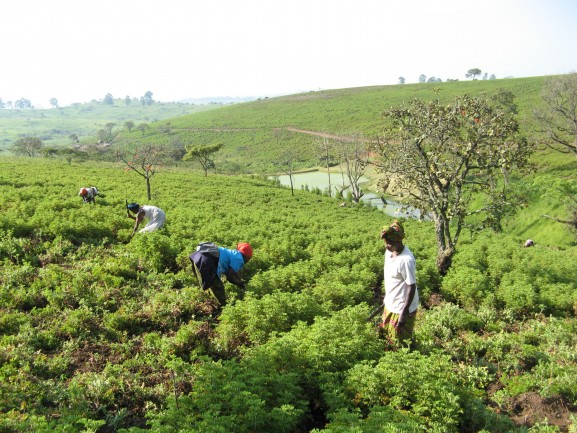
Geranium plantation in East Congo, source: http://www.in2ni.com/essential-oil-production-in-east-congo-ituri/
Site preparation
Good initial control of creeping grasses and other perennial weeds will be beneficial for this long term crop. After ploughing the site allow grasses and other weeds to establish vigorous young growth and spray with Roundup. After all growth is dead, apply manure at 10 t/ha if available, apply basal fertilizers, recultivate and prepare seedbed. Establish erosion barriers if on significant slope.
Planting material
It is essential to use the elite Reunion clones. Reunion oils command a significant price premium. As with all material that is introduced from different climatic environment, the possibility exists that the oil quality will change in character with time. The rate and type of change will have to be assessed.
Two alternative strategies for field planting exist:
- Take large cuttings from well-established plants (about 30 cms/12 inches long) making a sloping cut just below a node. Remove all the leaves from the lower half of the cutting. The cutting can be planted directly in the field
- Take small cuttings about 4-6 inches/10-15 cms of young shoot, with 3-4 nodes and a terminal shoot. The cuttings should have a well formed crown of leaves. The cutting should be taken by making a sloping cut just below a node. The cuttings are planted in shaded nursery beds at 10 x 10 cm spacing, with at least 2 nodes below the surface, and kept well-watered over the first week. The nursery bed should be well prepared with a basal NPK fertilizer. Shade can be progressively reduced once it is clear that the cuttings have started to root, and from 21 days onwards a week seedling liquid feed can be given weekly. Plants should be ready for transplanting to the field after about 40 days from planting.
For standard large scale field establishment method (1) should be used, during periods of reasonable rains, and should give satisfactory establishment. Gap up at 1 month after planting. Where planting material is restricted and a high rate of multiplication is required, or the season is very dry, use (2).
For both methods, cuttings should be dipped in a fungicide/ rooting hormone mixture before planting. A dry mixture can be made using Captan and Seradix B-2 (rooting hormone) using 1 measure Captan to 10 measures of Seradix. Alternatively a standard solution of Benlate can be prepared (2 g per gallon), the cutting dipped in this and then dipped in the Seradix powder.
Never take cuttings from poor/diseased plants.
Rapid multiplication of initial introductions of elite planting material is by apical tip cuttings at 1000 ppm IAA under mist with bottom heat at 20-250C. Use modules.
Plant populations
A population of around 50000 per hectare is required. Spacings of 80 x 25 cms, 70 x 30 can be used – the latter should give more rapid ground cover and reduce early weeding. Roadways can be left for collection and carting of harvested material to the still and return of the spent plant material after distillation. Throughout the life of the crop, diseased, wilting, or dead plants should be removed and destroyed, the soil drenched with 0.5% Bordeaux mixture (5g/l), and the space replanted with new cuttings.
Fertilizer
The crop will benefit from application of manure before planting, and a basal NPK dressing. Subsequent fertilizer applications should be made after each cut, and the plant residue from the distillation process should be returned to the field as a mulch. Additional manure and other compost material can also be added after each cut. This will reduce weeding and improve fertility and yields.
Standard annual fertilizer dressings are in the range:
| N | 130 kg/ha |
| P2O5 | 90 kg/ha |
| K2O | 100 kg/ha |
These should be adjusted in relation to the status of the soil and level of manure application.
Weeding
Hoe after harvesting or apply herbicide. For herbicides a cover must be used on the spray nozzle to prevent spray falling on the geranium plants.
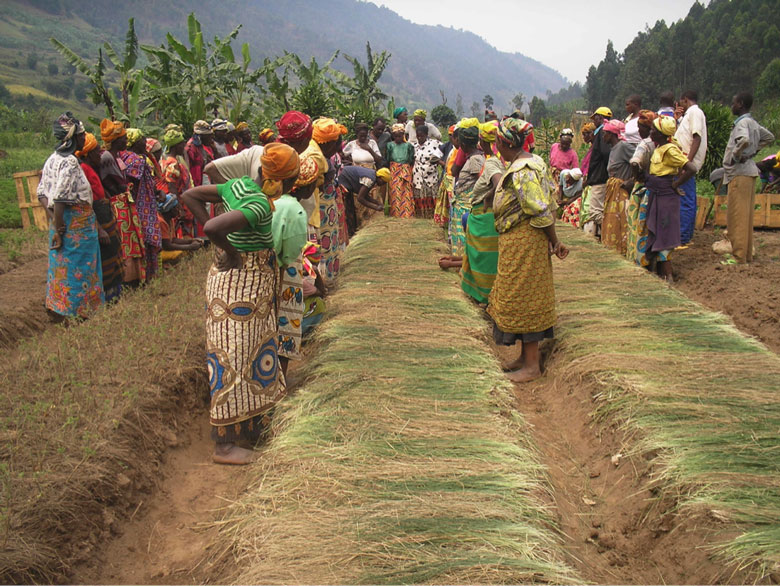
Rwandan women learning how to prepare an open geranium nursery, source: http://www.vsconfronts.org/news-and-commentary/vs-article/shared-trade-partnership-for-greater-social-impact/
Crop protection
Only agrochemicals that are approved for use for both the crop, the origin and the end market should be used.
The main disease problems are likely to be fusarium root rot and anthracnose leaf blight. Root rot leads to wilting and the disease plants should be removed, the soil drenched and the site replanted as outlined above. Anthracnose will be most prevalent during the wet seasons with full grown plants. Spray with Captan at 0.2 to 0.5% a.i. monthly during the wet seasons to prevent occurrence. Control of established infections will be difficult to achieve. Use a powered mistblower to achieve good penetration of the spray through the canopy.
No major insect pests are expected. If pest problems occur, spray with Dimethoate (Rogor) at 845 mls/ha in 500 litres water/ha (or more if canopy is very dense) at 2 week intervals until problem is removed. Dimothoate or other systemic insecticides should not be used within six weeks of harvesting.
Harvesting
From field planting to first cutting – approx 6 months. After the first cutting, 3 to 5 cuttings are taken a year. Frequency will depend on site fertility and rainfall/irrigation levels. Time of cutting is determined mainly by the state of growth. Detailed determination of the optimum time of cutting is dependent on a change in the scent of crushed leaves from lemon-like to rose-like. Oil is concentrated in the leaves and young shoots. Old stems contain very little or no oil. These should be cut off the plant, but removed from the young shoot material and left in the field. The plant is harvested when it has made a good level of new growth, but before a large number and weight of old stems have been produced. Economic production is unlikely if less than 3 cuts are taken a year, although final assessment depends on oil content of the plants at each cut.
At each cutting, if this is done manually, the entire canopy is removed with the exception of one complete branch which is left to continue to supply nutrients to the plant. When sufficient new leaf growth has been made to support the plants growth, the remaining branch is cut. With mechanised forage harvesting, the complete canopy is cut, and care must be taken that the cutting height is not set too low, or regrowth will be slow, and the plants may die.
The crop is effectively a long term perennial and can remain in the field for 10 or more years. Commercial life will depend on the health and vigour of the stand and the rotation requirements of the farm. 3 to 5 years may prove to be an economic and practical crop life.
Post-harvest
The cut material should be distilled the same day as it is cut. Distillation is by wet steam. Oil yields should be in the range of 60-70 kg/ha/year.
(The IFEAT socio-economic study of geranium published in IFEAT World July 2015 was used as the source of much of the production information in this note.)
Source:
Essential Oils and Oleoresins: Market Insider, July 2015 Report. International Trade Center. Source link here

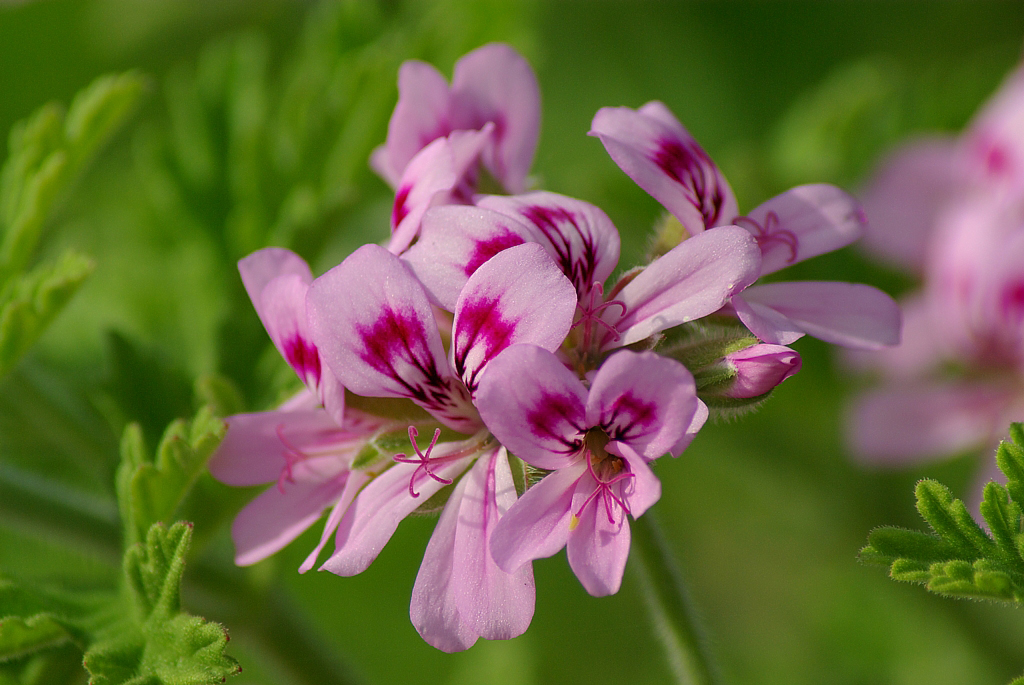
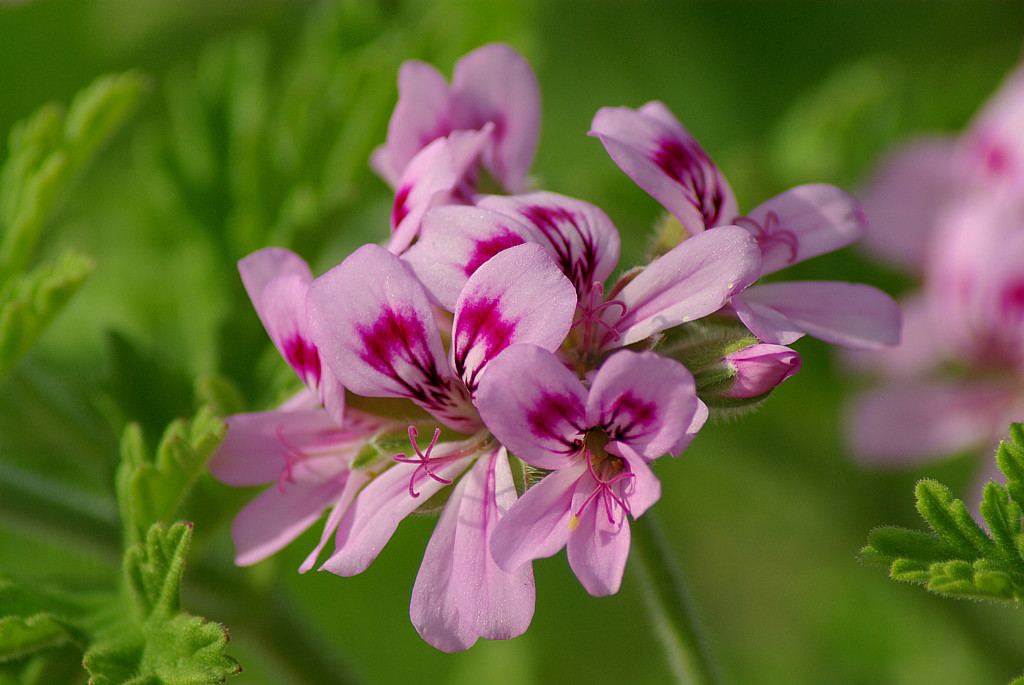
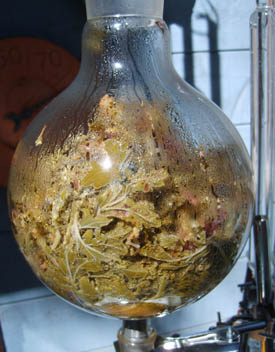
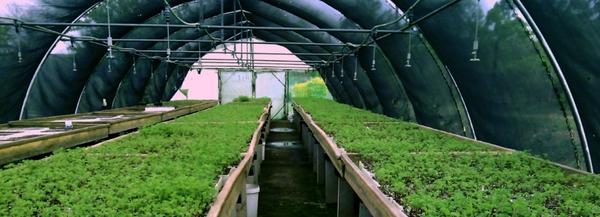

0 Comments